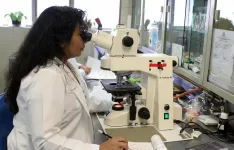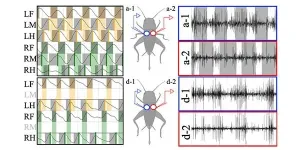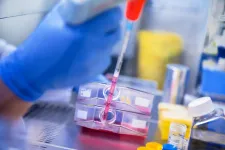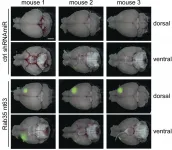INFORMATION:
For more information, please contact
Emma McKinney,
Communications Manager, University of Birmingham, on
+44 7815607157.
Alternatively, contact the Press Office out of hours on +44 (0)7789 921165.
Notes to Editors
The University of Birmingham is ranked amongst the world's top 100 institutions, and its work brings people from across the world to Birmingham, including researchers and teachers and more than 6,500 international students from nearly 150 countries.
Kellaway et al (Jan, 2021). Different mutant RUNX1 oncoproteins program alternate haematopoietic differentiation trajectories. Life Science Alliance. DOI: 10.26508/lsa.202000864
Read the paper here: https://www.life-science-alliance.org/content/4/2/e202000864
The Kay Kendall Leukaemia Fund was established in 1984 under the Will of the late James Sainsbury CBE. It awards grants for research on aspects of leukaemia and for relevant studies on related haematological malignancies. Grants are awarded for first class research on innovative proposals, particularly those close to the care of leukaemia patients or the prevention of leukaemia or related diseases. Scientific research awards are for Project grants and Intermediate and Junior Fellowships. The Fund also considers support for projects that will have direct benefit to leukaemia patient care.
Cancer research reveals how mutations in a specific gene cause different types of disease
2021-01-14
(Press-News.org) Leading cancer experts at the University of Birmingham have solved a long-standing question of how various types of mutations in just one gene cause different types of diseases.
A team of scientists at the University's Institute of Cancer and Genomic Sciences, led by Professor Constanze Bonifer, studied a gene known as RUNX1, which is responsible for providing instructions for the development of all blood cells and is frequently mutated in blood cancers.
The results of their research has shown that the balance of cells types in the blood is affected much earlier than previously thought, which is particularly important for families that carry the mutant gene.
The research, published in Life Science Alliance, opens up the possibility of identifying early changes in cells of patients carrying the mutation even before any disease manifests itself - increasing their chances of survival.
The study, the culmination of four years of research, showed that whilst some types of RUNX1 mutations directly changed how other genes behaved in blood cells, not all did. In particular, the mutations that are inherited through families do not immediately affect the cells but instead change the roadmap they follow to become other cell types, such as platelets and white blood cells.
Lead author Professor Constanze Bonifer said: "The most important results we found came from studying mutations that run in families which predisposes their members to diseases such as Familial Platelet Disorder (FPD) and Acute Myeloid Leukaemia (AML).
"AML is an aggressive cancer of the white blood cells, whereas in FPD, the ability to produce blood clots which is required to stop bleeding is impaired. Prior to this study, it was completely unclear why changes in just one gene cause so many different diseases."
Co-corresponding author Dr Sophie Kellaway said: "We used a cell culture system capable of generating blood cells in vitro, then induced the mutant forms of RUNX1 in these cells and immediately examined the effect on cellular behaviour and gene activity.
"We found that every RUNX1 mutation changed cells in a different way and had a different impact on how genes responded.
"What we have been able to demonstrate is that different genetic alterations in RUNX1 can send cells towards alternate paths of malignancy."
This work was funded by grants from the Kay Kendall Leukaemia Fund, the Biotechnology and Biological Sciences Research Council, and Blood Cancer UK.
Rachel Kahn, Research Communications Manager at Blood Cancer UK said: "This detailed research shows that it's not only a mutation that's important in deciphering whether or not someone will develop a disease, but it's precisely where the mutation occurs that can alter how blood cells develop and lead to disease.
"Many blood cancers are difficult to treat and have a poor prognosis. This is particularly the case for AML, which was studied in this research. Understanding more about what specific changes lead to the disease will help us to tailor treatments in the future, giving everyone the best possible chance of survival."
The research results demonstrate that different classes of mutant RUNX1 proteins use unique multifactorial mechanisms to cause disease and so development of novel treatments will require an individual approach.
The team now plans to work with clinicians and families carrying mutant RUNX1 proteins, to examine patient blood cells to see whether their findings in cultured cells can also be seen in patient blood cells, in particular, before they develop any symptoms. They will then examine whether they can find ways to restore normal blood cell development.
ELSE PRESS RELEASES FROM THIS DATE:
How insects activate muscles to adapt to limbs removed
2021-01-14
Adaptability explains why insects spread so widely and why they are the most abundant animal group on earth. Insects exhibit resilient and flexible locomotion, even with drastic changes in their body structure such as losing a limb.
A research group now understands more about adaptive locomotion in insects and the mechanisms underpinning it. This knowledge not only reveals intriguing information about the biology of the insects, but it can also help to design more robust and resilient multi-legged robots that are able to adapt to similar physical damage.
The insect nervous system is comprised of approximately 105 to 106 neurons. Understanding ...
Posidonia marine seagrass can catch and remove plastics from the sea
2021-01-14
Posidonia oceanica seagrass -an endemic marine phanerogam with an important ecological role in the marine environment- can take and remove plastic materials that have been left at the sea, according to a study published in the journal Scientific Reports. The article's first author is the tenure-track 2 lecturer Anna Sànchez-Vidal, from the Research Group on Marine Geosciences of the Faculty of Earth Sciences of the University of Barcelona (UB).
The study describes for the first time the outstanding role of the Posidonia as a filter and trap for plastics in the coastal areas, and it is pioneer ...
Faeces and algorithms: Artificial Intelligence to map our intestinal bacteria
2021-01-14
Both past and present-day scientists have suspected the intestines of playing a role in various diseases. Present-day studies focus on the intestinal flora's role in physical diseases such as diabetes and overweight, while others seek to establish a connection between the intestinal flora and e.g. autism, schizophrenia and depression. But even modern-day scientists have difficulties studying the around 500-1000 different species among the approx. 100 billion active bacteria in our intestines.
Therefore, researchers from the University of Copenhagen have developed a ground-breaking technique that ...
Teeth pendants speak of the elk's prominent status in the Stone Age
2021-01-14
Roughly 8,200 years ago, the island of Yuzhniy Oleniy Ostrov in Lake Onega in the Republic of Karelia, Russia, housed a large burial ground where men, women and children of varying ages were buried. Many of the graves contain an abundance of objects and red ochre, signifying the wish to ensure the comfort of the buried also after death. Pendants made of elk incisors were apparently attached to clothing and accessories, such as dresses, coats, cloaks, headdresses and belts. Although no clothing material has been preserved, the location of the elk teeth sheds light on the possible type of these outfits.
A people of grooved elk tooth pendants
A study headed by archaeologist Kristiina Mannermaa, University of Helsinki, aimed to determine who ...
Greenland melting likely increased by bacteria in sediment
2021-01-14
Bacteria are likely triggering greater melting on the Greenland ice sheet, possibly increasing the island's contribution to sea-level rise, according to Rutgers scientists.
That's because the microbes cause sunlight-absorbing sediment to clump together and accumulate in the meltwater streams, according to a Rutgers-led study - the first of its kind - in the journal Geophysical Research Letters. The findings can be incorporated in climate models, leading to more accurate predictions of melting, scientists say.
"These streams can be seen all over Greenland ...
Bladder cancer -- When to use chemotherapy
2021-01-14
In patients with bladder cancer, chemotherapy effectiveness is partially determined by the body's immune system response to the malignancy. This is the conclusion of research conducted by a team of scientists from Charité - Universitätsmedizin Berlin and the Berlin Institute of Health. The findings, which have been published in Science Translational Medicine*, can be used to predict treatment success and may increase survival in patients with bladder cancer.
Bladder cancer is one of the ten most common types of cancer in Germany, and one of the five most common cancers in men. Nationwide, the disease affects approximately 30,000 people a year. The risk of the cancer ...
Moffitt researchers discover biochemical pathway that protects cells from ferroptosis
2021-01-14
TAMPA, Fla. -- The hallmarks of cancer include rapid cell reproduction and metabolic activity. But these processes also lead to increased cellular stress and oxidation, and the risk of cell death. To circumvent these negative consequences of supercharged growth, cancer cells stimulate pathways to reduce oxidative stress and avoid cell death. In an article published in Cell Metabolism, Moffitt Cancer Center researchers report on a newly discovered biochemical pathway that protects cells from a type of cell death called ferroptosis.
Ferroptosis is a specialized type of cell death that is caused ...
MicroRNA may serve as therapeutic targets for traumatic brain injury
2021-01-14
Scientists at the Walter Reed Army Institute for Research have shown that microRNA biomarkers related to Alzheimer's disease play a role in brain damage caused by traumatic brain injury.
TBI or brain trauma results from blows to the head, leading to chronic disruption of the brain and a cascade of long-term health conditions. Patients who suffer from TBI are at much higher risk of developing neurodegenerative disease or dementia, particularly Alzheimer's disease. The mechanism behind this relationship remains understudied, making the development effective therapeutics challenging.
MiRNAs are small pieces of genetic material that play a critical role in normal gene expression. Yet, studies have also linked abnormal miRNA levels, or dysregulation, to a range of diseases including neurodegenerative ...
USTC makes security analysis and improvement of quantum random number generation
2021-01-14
Recently, the research team led by academician GUO Guangcan from the University of Science and Technology of China of the Chinese Academy of Sciences has made security analysis and improvement of source independent quantum random number generators with imperfect devices.
By studying the actual characteristics of the measurement devices of the source-independent quantum random number generation, the researchers pointed out that the security issues were caused by afterpulse, detection efficiency mismatching, poor sensitivity to photon number distribution ...
Researchers link cellular transport pathway to aggressive brain cancer
2021-01-14
Researchers at McGill University have identified a new cellular pathway that limits the growth and spread of brain tumors by controlling the recycling of cell surface receptor proteins. The study, which will be published January 14 in the Journal of Cell Biology (JCB), suggests that the pathway, which involves a protein called Rab35, is defective in many patients with glioblastoma and that restoring Rab35's activity could be a new therapeutic strategy for this deadly form of brain cancer.
Glioblastoma is the most aggressive type of brain cancer, and because it is largely untreatable, the average patient dies within 14 months of diagnosis. Like in other cancers, the proliferation and spread of glioblastoma cells depends on various receptor proteins on the outside of the cell. The ...






